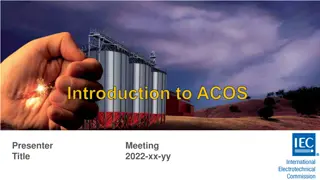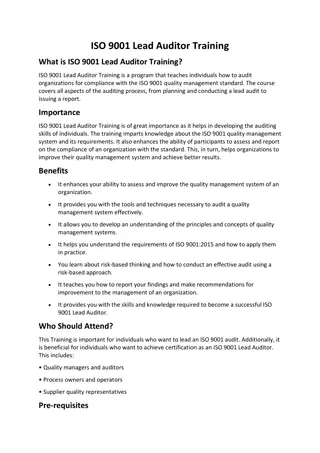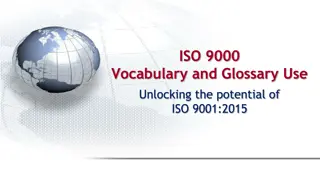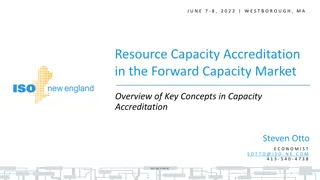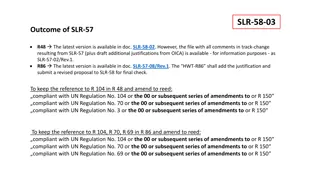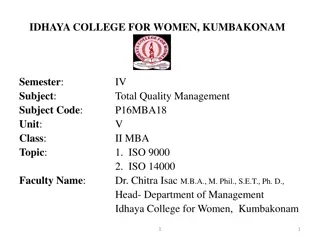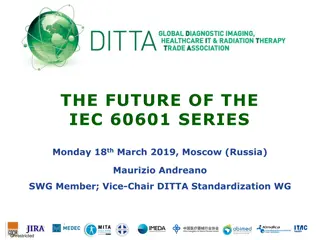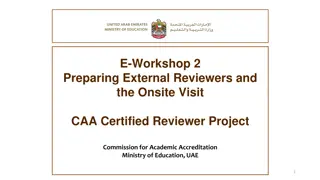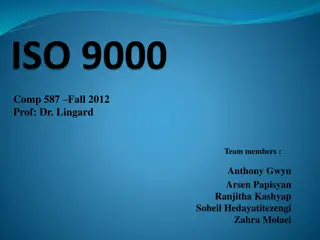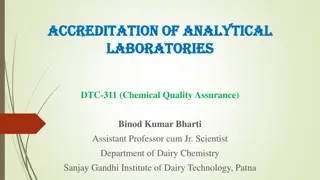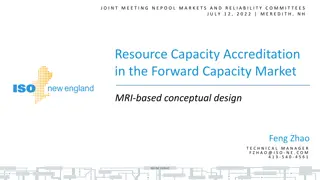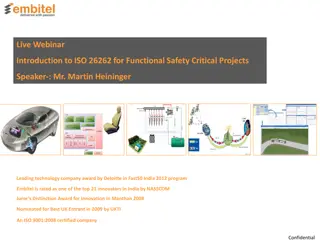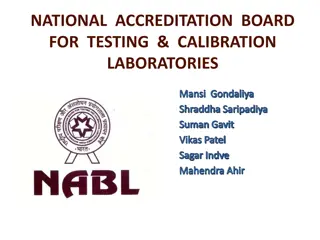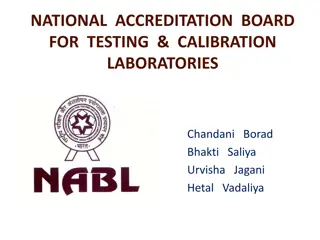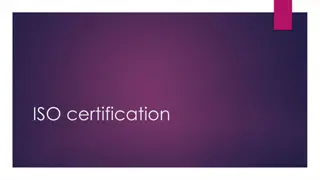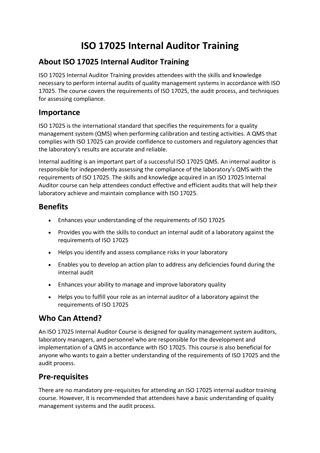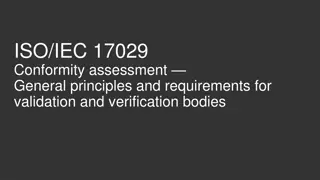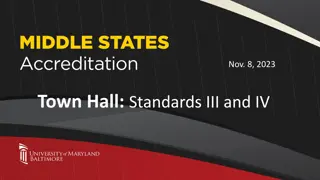Understanding ISO/IEC 17024 Accreditation Process and Standards
Delve into the world of ISO/IEC 17024 accreditation standards with key insights from industry experts. Learn about the revision process, checks for impartiality, and the role of ISO, CASCO, and WG30. Gain knowledge on conformity assessment practices and the development of ISO/IEC 17000 series standards for a global perspective on accreditation frameworks.
Download Presentation

Please find below an Image/Link to download the presentation.
The content on the website is provided AS IS for your information and personal use only. It may not be sold, licensed, or shared on other websites without obtaining consent from the author. Download presentation by click this link. If you encounter any issues during the download, it is possible that the publisher has removed the file from their server.
E N D
Presentation Transcript
ISO/IEC 17024 A Primer March 14, 2023 Professional Testing Inc. Sponsor Session
The Presenters: Dr. Cynthia Woodley Chief Operating Officer & Psychometrician Professional Testing Inc. ISO/IEC 17024 Revision WG Convenor Dr. Reed Castle Executive Vice President & Psychometrician Professional Testing Inc. ISO/IEC 17024 ANAB PCAC Member Dr. Adrienne Cadle Vice President, Credentialing & Psychometrician Professional Testing Inc. ISO/IEC 17024 ANAB Assessor ISO/IEC 17024 Revision WG Member Dr. Roy Swift Executive Director Workcred, an ANSI Affiliate ISO/IEC 17024 Revision WG Member 2
Presentation: Dr. Woodley - High level overview of ISO, ISO CASCO and WG30 Dr. Castle - current accreditation process in the US (ANAB) Dr. Cadle - The standard and the checks and balances to obtain impartiality, objectivity, and inter-rater reliability Dr. Swift - Process for revision of the Standard and areas that will be considered for review and addressing the issues of today Q&A 3
Introduction to ISO: An independent, non-governmental international organization with a global network of national standards bodies - one member per country 167 member countries ISO develops International Standards - > 24,675 812+ technical committees/subcommittees developing/revising 100+ standards every month Coordinated by a Central Secretariat in Geneva
CASCO Stands for Conformity Assessment Committee -is a policy committee that reports directly to ISO council and ensures a consistent approach to conformity assessment. -Develops standards jointly with IEC related to conformity assessment practices. These are the ISO/IEC 17000 series standards referred to as the CASCO Toolbox. -does not perform conformity assessment activities.
CASCO structure CASCO Plenary Technical Working Groups Policy Policy Groups WG1 CPC Development ISO/IEC 17XXX Chairman s policy and coordination group CASCO WG2 TIG Development ISO/IEC 17XXX Technical Interface Group STAR WG30 Strategic Alliance and Regulatory Group Development ISO/IEC 17024
ISO/IEC 17000 series The development of the ISO/IEC 17000 series allows a harmonized and consistent approach to conformity assessment which positively impacts market access and facilitates international trade Standards for the operation of: conformity assessment bodies laboratories, certification bodies inspection bodies accreditation bodies peer evaluation and other associated activities
CASCO Toolbox Management Systems Product Process Service People Inspection Claims Laboratory ISO/IEC 17021-1 and parts ISO/IEC 17065 ISO/IEC 17024 ISO/IEC 17020 ISO/IEC 17029 ISO/IEC 17025 Certification scheme for process ISO/IEC 17032 Example of certification schemes ISO/IEC TR 17028 Fundamentals for products ISO/IEC 17067 Vocabulary for personnel ISO/IEC 17027 Proficiency testing ISO/IEC 17043 Audit duration ISO/IEC TS 17023 Core conformity assessment standards Reference material producers ISO 17034 Tangible products ISO/IEC TR 17026 Suppliers declaration Use of marks Use of marks by third parties Good CA practices Accreditation standard Peer assessment Terms and definitions Guide for drafting normative documents ISO/IEC 17050 parts 1 and 2 ISO/IEC Guide 23 and ISO Guide 27 ISO/IEC 17030 ISO/IEC Guide 60 ISO/IEC 17011 ISO/IEC 17040 and ISO/IEC Guide 68 ISO/IEC 17000 ISO/IEC 17007 Note: valid in 2019
Outputs from conformity assessment Party performing conformity assessment Functional approach Conformity assessment standard Conformity assessment activity Surveillance (when needed)b Outputs Selection, Second partya First party Third party Determination, Review and Attestation Stages Certification of management systems Certification of products, processes and services Certification of persons ISO/IEC 17021-1 Certificate ISO/IEC 17065 Certificate ISO/IEC 17024 ISO/IEC 17020 ISO/IEC 17029 ISO/IEC 17025 Certificate Inspection Report Validation and verification Statement or claim Testing Report Supplier's declaration of conformity aAt present, ISO and IEC do not have specific International Standards or Guides for second-party conformity assessment systems. Second-party conformity assessment systems can be developed to rely on first-party declarations, third-party attestations and certification, or second-party acceptance criteria. ISO/IEC 17050 Declaration bSurveillance is part of the conformity assessment system and not an external market surveillance activity.
Accreditation body groups (regional or international) ISO/IEC 17040 How it fits together Peer Evaluates Conformity Assessment Bodies (CABs) Accreditation body (AB) ISO/IEC 17011 Validation and Verification Body ISO/IEC 17029 Management system certification body ISO/IEC 17021-1 Person certification body ISO/IEC 17024 Product, process and service certification body ISO/IEC 17065 Inspection body ISO/IEC 17020 Laboratory ISO/IEC 17025 Accredits NOTE: Accreditation applies only to 3rd party CABs Audits & Certifies Audits & Certifies Audits & Certifies Tests & Reports Validates/Verifies & Issues Statements Inspects & Reports Commodities, items, facilities or installations meet specific requirements Products, processes and services meet specified requirements Products or samples meet specified requirements Company meets management system requirements Claims confirmed or not Person meets specific scope competencies
Working Group 30 (WG30) Same Working group that revised ISO/IEC 17024: 2012 and Developed ISO/IEC 17027 Each member country may have 3 representatives US: - Dr. Roy Swift (Workcred) - Dr. Adrienne Cadle (Professional Testing) - Andri Orphanides (American Petroleum Institute) International Accreditation Forum (IAF): - Dr. Vijay Krishna (ANAB) - Ms. Amy Kardel, JD (CompTia) 12
ANSI Mirror Committee ANSI in process of forming a Mirror Committee. Participants will have opportunity to join ANSI s Mirror Committee and provide feedback into the revision of the standard 13
Process 1. Become Familiar with the standard A. Purchase standard B. Attend a workshop C. Request an informal visit or pre-assessment 2. Complete and submit application 3. Obtain preliminary eligibility approval 4. Complete PCAC-FR-503 form and submit fees 15
Process continued 5. Assessor review A. document review B. onsite review C. corrective action process 6. Personnel Certification Accreditation Committee (PCAC) decision 7. Participate in annual surveillance and re-accreditation 16
Roles and Functions Assessors a. Two assigned b. Primary liaison between CB and ANAB c. Trained and calibrated frequently 17
Roles and Functions Continued Personnel Certification Accreditation Committee (PCAC) a. Meets quarterly b. Two types of general members c. Committee seeks balance (e.g., CBs, psychometricians, government, education) d. Votes to make accreditation decisions e. Role is limited to discussing assessor findings 18
Evaluation Task Group (ETG): 1. An ad-hoc group of members conducting detailed review of the results of the assessment 2. Two or more PCAC members and two assessors 3. Discuss assessment and make recommendations to PCAC 19
The standard and the checks and balances to obtain impartiality, objectivity, and inter-rater reliability
Major Components of ISO/IEC 17024:2012 4.0 General Requirements 7.0 Records and Information Requirements 5.0 Structural Requirements 7.1 Records of applicants, candidates and certified persons 5.1 Management and Organizational Structure 7.2 Public Information 5.2 Structure of the Body in Relation to Training 7.3 Confidentiality 7.4 Security 6.0 Resource Requirements 8.0 Certification Scheme 6.1 Personnel
Major Components of ISO/IEC 17024:2012 - Continued 9.0 Certification Process Requirements 9.1 Application 9.2 Assessment 9.3 Examination 9.4 Decision on Certification 9.5 Suspending, Withdrawing or Reducing the Scope of Certification 9.6 Recertification 9.7 Use of Certificates, Logos and Marks 9.8 Appeals 9.9 Complaints 10.0 Management Systems Requirements
Areas of Nonconformities Outsourcing 6.3.1 and 6.3.2 Test Security 7.4.3.f Certification Scheme 8 Psychometrics 9.3.1 and 9.3.5 Recertification 9.6.3 and 9.6.5 Document Control 10.2.3 Management Review 10.2.5 23
Process for Revising a Standard A vote by 167 countries is needed to determine that the standard should be revised The official delegation work on revised drafts that are sent to all participating countries for comment There may be several rounds of drafts depending on the quantity of the comments Workshops are often conducted to help countries understand the new standard Once it has been determined to revise, each country sends two- three delegates to participate in the revision process Each comment must be addressed to determine if it is accepted, partially accepted, or rejected Then there is a final draft process and the standard is officially published Countries then adopt the standard as a national standard in their country 25
Areas that will be explored during the revision process Proctoring of examinations Collection of administrative data that will help look at: Economic upper mobility of those who hold the certification The effect of closing racial, gender, and cultural disparities Longitudinal impact on careers Quality of the job analysis to ensure alignment with industry Ensuring multiple pathways to the certification exam and documentation regarding the equity between the pathways Integration of certifications with other types of credentials such as academic degrees or academic micro-credentials 26
Roy Swift, Ph.D. Executive Director, Workcred rswift@workcred.org Cynthia D. Woodley, Ed.D. cdwoodley@proftesting.com 1899 L Street, NW Washington, DC 20036 www.workcred.org facebook.com/workcred/ linkedin.com/company/workcred-inc/ twitter.com/workcred/ youtube.com/@workcred blog.ansi.org/workcred/ Reed Castle, Ph.D. rcastle@proftesting.com Adrienne Cadle, Ph.D. acadle@proftesting.com



